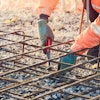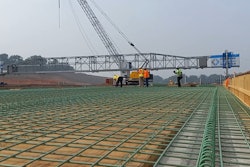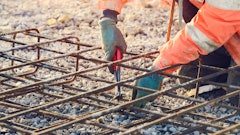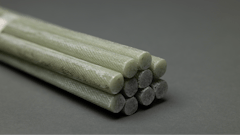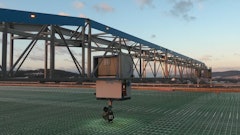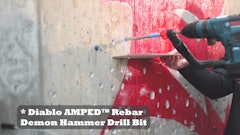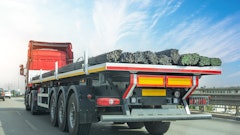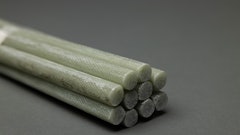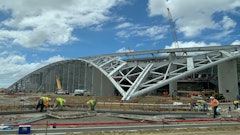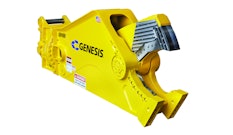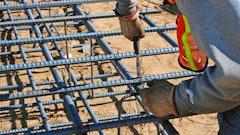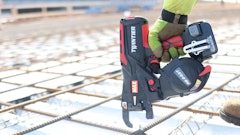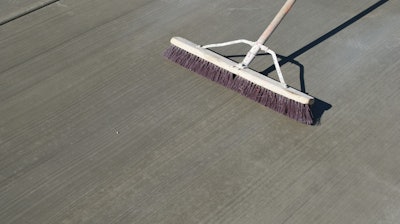
As the demand for more sustainable construction grows and raw material shortages like steel continue to be a challenge, fiber-reinforced concrete has become an increasingly popular choice for flatwork and elevated construction—from precast and ready-mix concrete to shotcrete.
Fibers make concrete significantly more resistant to cracking from plastic and drying shrinkage, leading to a highly durable end product with a longer lifespan. Some fiber types can even greatly reduce construction time and, in some applications, eliminate the need for conventional steel.
Why Use Fibers in Concrete?
Regarded as a cost-effective, durable and even sustainable alternative to conventional steel like rebar and wire mesh, fiber-reinforced concrete boasts a variety of benefits: 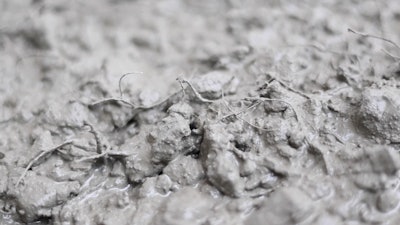 Macrofiber provides three-dimensional reinforcement against crackingThe Euclid Chemical Corporation
Macrofiber provides three-dimensional reinforcement against crackingThe Euclid Chemical Corporation
- Prevents plastic and drying shrinkage cracks
- Enables faster construction times and lower labor costs
- Finishes smoothly with any surface fibers quickly fading under foot/vehicle traffic
- Provides same level of reinforcement as wire mesh with even distribution throughout concrete
- Eliminates the need for chairs to support conventional steel rebar and wire mesh
- Well recognized by major concrete organizations and tested to industry standards
How Synthetic Fibers Compare to Steel
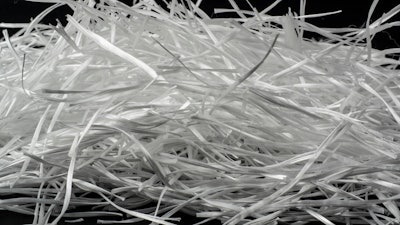 Synthetic macrofiber reinforcementThe Euclid Chemical Corporation
Synthetic macrofiber reinforcementThe Euclid Chemical Corporation
Macro-synthetic fibers not only provide resistance to plastic shrinkage but also enhance concrete’s durability, toughness and limited structural capacity when properly designed. Dosed at amounts equivalent to conventional reinforcement, these fibers are distributed three dimensionally throughout the concrete section.
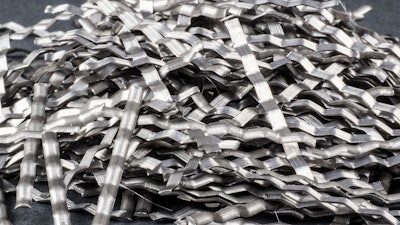 Typical steel fiber reinforcementThe Euclid Chemical Corporation
Typical steel fiber reinforcementThe Euclid Chemical Corporation
Can synthetic fibers compete “head-to-head” with steel? Absolutely. Macrofibers offer durability and residual strength capacity equivalent to steel. Assuming an adequate fiber design is performed, macro-synthetic fibers generally require 5-10 times less weight of material compared to steel, streamlining on-site handling and storage. They are also non-magnetic and non-corrosive, making them ideal for exterior pavements where aesthetics and safety are a concern. Since concrete containing macrofibers is mixed, the fiber also becomes somewhat pliable and not nearly as abrasive to pumping lines and equipment.
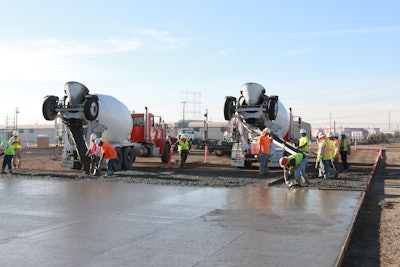 Macrofiber reinforcement provides cost savings over rebar and welded wireThe Euclid Chemical Corporation
Macrofiber reinforcement provides cost savings over rebar and welded wireThe Euclid Chemical Corporation
CONCRETE FLOORING
Providing concrete floors with early-age cracking resistance, fiber reinforcement can be used to replace conventional steel for temperature/shrinkage crack control and limited structural applications. The three-dimensional reinforcement offered by macrofibers also offers greater abrasion, fatigue and impact resistance while increasing service life through enhanced durability.
Additionally, the concrete matrix’s increased tensile capacity can reduce overall shrinkage stresses, which allows for increased joint spacing. There are successful examples and significant industry research that support the increase of control joint spacing in floor designs with macro-synthetic and steel fibers. This is typically combined with improved concrete mix designs using advanced chemical admixtures as well as proper placement and curing practices.
Some fiber manufacturers have also experimented with joint-free floors. To extend joint spacing beyond traditional construction practices, there are many factors that must be considered. Low water-to-cement ratio, lower cement content, and shrinkage reducing and/or compensating admixtures with adequate curing yields strong durability with reduced risk for curling and shrinkage cracks. Other factors such as proper subgrade preparation, placement, saw-cut depth, curing time and exposure conditions must also be evaluated.
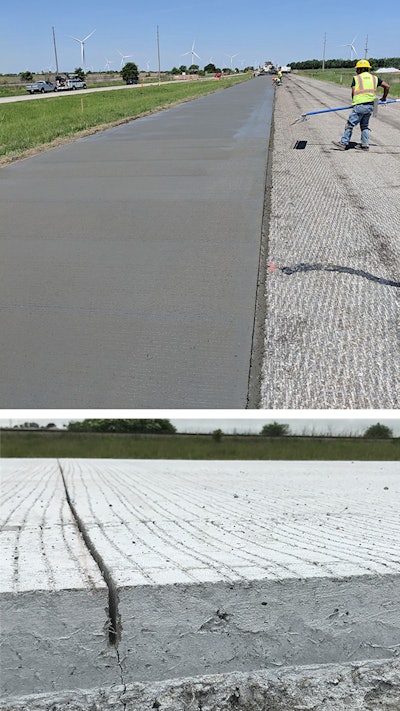 Concrete pavement with macro-fiber reinforcementThe Euclid Chemical Corporation
Concrete pavement with macro-fiber reinforcementThe Euclid Chemical Corporation
CONCRETE PAVEMENT
Fiber-reinforced concrete is also a cost-effective, sustainable solution for resurfacing and rehabilitating existing pavements and bridge decks. In fact, many state DOTs and other transportation agencies are promoting macrofibers over conventional steel and developing performance-based specifications for pavement overlays and full-depth replacement systems to increase service life and reduce long-term maintenance costs.
Macro-synthetic fibers significantly reduce or even completely eliminate the expense and installation time of conventional reinforcement, while producing concrete pavements that are easily placed with less environmental impact on the jobsite.
CONCRETE WALL SYSTEMS
Macro-synthetic fibers can also be used as an alternative to steel reinforcement with nearly any concrete wall application. The dosage rates are based on strength-to-strength calculations supported by standardized test methods and industry practices. This significantly reduces time and labor costs, while producing more durable concrete. These fibers can also provide the same strength capacity as steel in wall applications such as foundations and retaining walls.
Macro-fiber reinforcement can be used as a cost-effective, sustainable solution for buildings constructed with insulated concrete form (ICF) wall systems, which have historically been reinforced by steel rebar engineered to resist forces from soil, wind and other loading conditions. Dosed correctly, macrofibers eliminate rebar in ICF walls for significant time and cost savings.
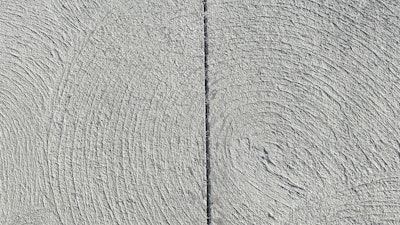 Typical fiber-reinforced concrete surface finishThe Euclid Chemical Corporation
Typical fiber-reinforced concrete surface finishThe Euclid Chemical Corporation
Considerations for Concrete Mix Design & Application
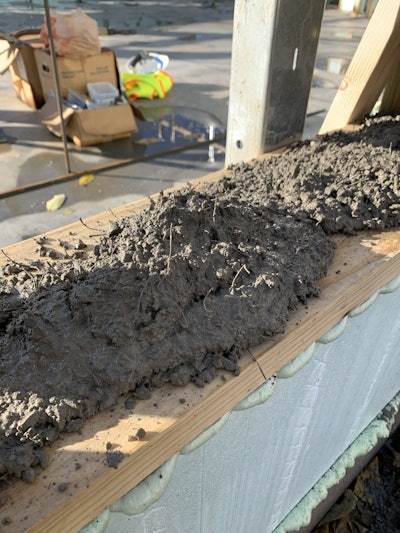 Fiber used insulated concrete form constructionThe Euclid Chemical Corporation
Fiber used insulated concrete form constructionThe Euclid Chemical Corporation
To improve the workability of fiber-reinforced concrete, the ACI 544.3 standard offers recommendations and guidance to potentially modify the mix design. Additionally, the use of chemical admixtures like superplasticizers or water reducers increase the workability of concrete without adding water. It is recommended that trial batches are performed to ensure mixture workability.
Factors such as fiber material type, architecture, dimension and dosage may affect the surface finish of fiber-reinforced concrete, as well as the required surface-finishing method that is used. Stiff or rigid fibers typically have a greater tendency to protrude up through the slab than flexible fibers.
Proper external vibration is another key factor when finishing fiber-reinforced concrete. The general recommendation is to use the same finishing techniques and approximate timing as conventional concrete. When casting samples for testing, no internal vibration within the molds can be used. Synthetic fibers may delay bleed water at the surface, which impacts finish timing on larger slabs.
There are many broom finishing tips that minimize surface appearance, such as brooming in one direction or using specific broom bristles to align surface fibers. If necessary, a torch can burn off synthetic fibers on a concrete surface—but should not be used until all desired hardened concrete properties are achieved. When finishing industrial, commercial and warehouse floors where high dosage levels of macro-synthetic and steel fibers are used, a laser or vibrating screed is usually recommended.

